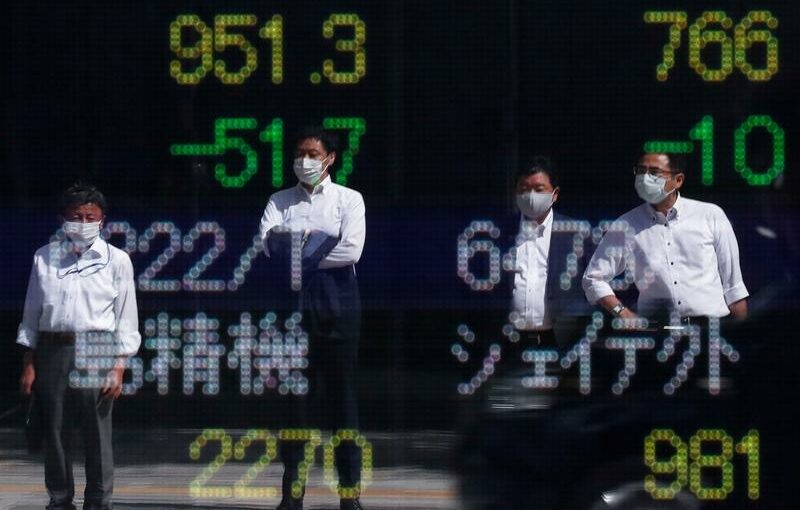HONG KONG (Reuters) – Asian shares managed to claw back some of this week’s heavy losses on Thursday but were headed for their worst quarter since the pandemic hit, while the dollar held near a one-year high, helped by broad safe-haven demand and U.S. rate hike prospects.
U.S. and European stock futures were also higher with S&P 500 e-minis rising 0.8%, the pan-region Euro Stoxx 50 futures gaining 0.76% and FTSE futures advancing 0.54%.
MSCI’s broadest index of Asia-Pacific shares outside Japan gained 0.33%, but was still set for a 4.4% monthly decline and a 9.3% loss on the quarter.
That would be the benchmark’s worst quarter since the first three months of 2020, as COVID-19 raged across Southeast Asia and investors worried about slowing global growth with China a particular concern. China’s economy has been hit by regulatory curbs in the tech and property sectors and is now grappling with a power shortage.
Data published on Thursday showed China’s factory activity unexpectedly shrank in September, but services returned to expansion as COVID-19 outbreaks receded.
However, analysts say slowing growth would pressure authorities to ease policy. That provided battered Chinese markets with some respite with blue chips rising 0.6% and the Shanghai Composite Index gaining 0.7%.
“We think China is at the inflection point of more cyclical policy easing amid ongoing rapid growth slowdown,” wrote analysts at Morgan Stanley in a note.
Elsewhere, the Hong Kong benchmark shed 0.3%, hurt by declines in Chinese tech names while Australia gained 1.9% and Korea’s KOSPI gained 0.3%.
The other main drag on investor sentiment in greater China was embattled developer China Evergrande, whose shares swung back and forth, and were last down 4.2%.
The company missed paying bond interest due on Wednesday, two bondholders said, missing its second offshore debt payment in a week, although the cash-strapped company is scrambling to meet its obligation in its home market.
The Nikkei lost 0.31% a day after Japan’s ruling party chose softly spoken consensus-builder Fumio Kishida as its new leader and the country’s new prime minister.
DOLLAR SURGE
In currency markets, the dollar held onto recent strong gains in Asian hours, with the dollar index – which measures the U.S. currency against six major currencies – at 94.304, just off a year-high hit overnight.
“(The dollar) is breaking key levels and there was no real resistance to the break so that tells you there was real underlying strength to that,” said Chris Weston, head of research at Melbourne brokerage Pepperstone.
“Sometimes, it can become somewhat of a magical currency,” he said, pointing to the fact that it was supported by both global investors seeking safety and the Fed inching closer to reducing its massive asset purchases.
In addition, “the ongoing U.S. debt ceiling stand‑off could briefly amplify financial market jitters and support the USD in the short-term,” said analysts at CBA in a note.
U.S. lawmakers continue to wrangle over funding the government but face a Friday deadline to prevent a shutdown approached, something that also capped gains in U.S. equities overnight.
The yield on benchmark 10-year Treasury notes was 1.5167%, little changed on the day, having risen sharply earlier in the week.
Oil prices edged lower, extending losses after official figures showed an unexpected rise in U.S inventories, reversing a run of recent gains.
Brent crude was down 0.5% to $78.25 a barrel while U.S. crude dipped 0.24% to $74.65. [O/R]
Spot gold traded at $1,731.99 per ounce, edging off its seven-week low, but still constrained by a strong dollar.
Source: Read Full Article
